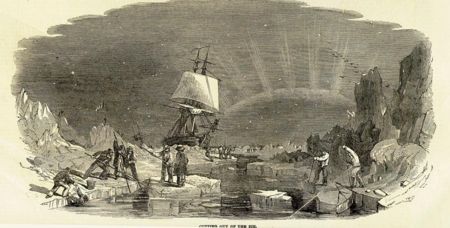Northwest Passage
This article is about the geographical Northwest Passage; for the film see Northwest Passage (film)
The Northwest Passage is a much-sought water route connecting the Atlantic and Pacific Oceans. Between the 16th century and the 19th century, European explorers, particularly the British, made numerous attempts to discover such a route north and west, through (by river) or around (by sea) North America: Captain John Smith, for example, sailed up the Chesapeake Bay from Jamestown in the early 1600s looking for a river that led to the Passage, but in the early 1800s Lewis and Clark proved there was no navigable water route through the continent of North America, so the theory was shifted northward, to be an all-sea route through the Arctic Archipelago around the north of Canada. The earliest of the explorations were based on a mixture of legend, conjecture, and wishful thinking, but later expeditions built on what was learned and gradually extended their maps, at first of North America itself and then of Arctic America in particular. The largest number of expeditions in search of the passage was launched by Great Britain in the mid-nineteenth century, begining in 1818 and continuing through the ill-fated expedition of Sir John Franklin in 1845, from which not a single man returned alive. The notion of an Open Polar Sea, though eventually proved chimerical as well, had a long-lasting influence on the search for the Passage and was still believed in by some navigators and geographers as late as the 1890's. Even after the claim of an Open Sea was disproved, the Passage retained its romantic allure, and when in 1905 the Norwegian explorer Roald Amudsen completed the first successful voyage through the Passage, the news electrified the world.
History
The earliest attempts to find a Northwest Passage were motivated not by the quest for exploration but by the thirst for gold. The Spanish legend of the Estrecho de Anián (= Strait of Anián) dated back to the late Middle Ages and was already venerable in 1539 when Hernán Cortés sent Francisco de Ulloa to sail up the inland side of Baja California in search of it. It was not, however, the Spanish who were to be most persisent in this quest, but the British, whose sense of entitlement to the more "septentrional" (northerly) regions of the "New World" was first set forth by Dionyse Settle, the official propagandist for Sir Martin Frobisher's series of expeditions to the Arctic in the later 1570's.:
- "Svch countries and people, (good Christian Reader) which almost from the deluge, or at the least, so long as anye human creature hath had habitation on the earth, haue of late yeres, by the industrie of diligent searchers ben explored: it hath likewise pleased God, that they should be found out by those people, which for the temperature of their habitation, are most apt to atchiue the fame. As for example the Spaniards, the West Indies. Spaine is situated much more neere the Tropike of Cancer, then other Christian countries be: whereby, the Spaniards being better able to tolerate Phoebus burning beames, then others whiche are more Septentrional then they. Wherefore, I suppose them the most apte men for the inioying of the habitation of the West Indies: and especially so much, as is vexed with continual heate, or that is agreeable to their temperature, God hath bene pleased that they, as the most apt people, should both explore & inioy the same . . . [so] it hath plesed God, at this present, by the great diligence & care of our worthie countrieman, Master Martine Frobisher, in the 18. and 19. yeare of oure Queenes Maiesties reigne, to discouer, for the vtilitie of his Prince and Countrie, other regions more Septentrional, then those before rehearsed: which, from the beginning, as vnknowne till nowe, haue bene concealed and hidden. Which discouerie, I iudge most apt for vs English men, and more agreeing to our temperature, then others aboue rehearsed."
Frobisher's three voyages, the last of which in 1578 involved a whole flotilla of ships with the intent to colonize Baffin Island, were premised on the supposed gold content of black stones he found there; when the optimistic assays were proved false -- the stones were, after all, just stones -- Elizabethan explorers abandoned the plan, but the dream of a Northwest Passage became a long-held and much-tried dream of English sailors from Hudson to Sir John Franklin.
Chronology of the Search for the Passage
- 1539: Francisco de Ulloa up the inland side of Baja California in search of the legendary Strait of Anián.
- 1576 - [[1578: Martin Frobisher's three voyages to Baffin Island in search of the passage
- 1585: The English explorer John Davis entered Cumberland Sound, Baffin Island.
- 1609: Henry Hudson sailed up Hudson River in search of the passage; he later explored Hudson Bay, where he presumably met his death after being set adrift by his mutinous crew.
- 1619: Norwegian Jens Munk sought the passage.
- 1791-1795: The Vancouver Expedition surveys in the inland waters of the Northwest Coast, proving that no passage exists south of the Bering Strait.
- 1818 Sir John Ross circumnavigates Baffin Bay, but returns without venturing into Lancaster Sound.
- 1819-1820 William Edward Parry, Ross's former second-in-command, enters Lancaster Sound and earns the Parliamentary Prize.
- 1845 Sir John Franklin's ill-fated expedition departs from Greenhithe.
Bibliography
- Voyages of Delusion: The Quest for the Northwest Passage, by Glyn Williams, Yale University Press, 2002 (ISBN 0300098669)
- Arctic Journeys: A History of Exploration for the Northwest Passage (American University Studies Series IX, History), by Miller Graff [ISBN 0820417459 (1992 hdbk)]
- Across the Top of the World: The Quest for the Northwest Passage, by James Delgado, Checkmark Books 1999 (ISBN 0816041245)
